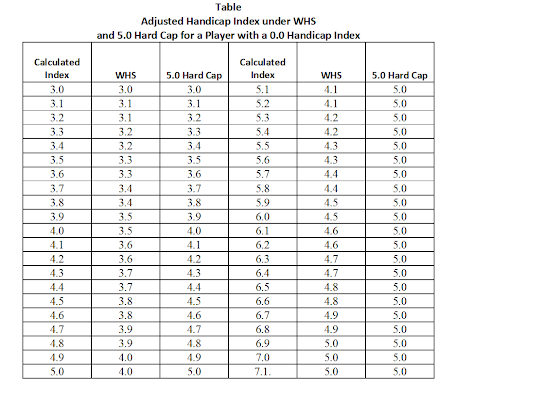A previous post (The World Handicap System Penalizes the
Honest Player, July 21, 2020) discussed how the exceptional score reduction in Rule
5.9 of the World Handicap System (WHS) was unfair to the honest player. The intentions behind the adoption of Rule 5.9
were good but misguided. The WHS
eliminated Section 10-3 of the USGA Handicap System that reduced a player’s
Handicap Index for exceptional tournament scores. While the USGA’s Section 10-3 was not
effective, it was at least an attempt to ensnare the unethical player.
The WHS needed something to replace the USGA’s efforts and thus Rule 5-9 was born. Rule 5.9 differed from the old Section 10-3 in three important respects. First, exceptional performance was no longer limited to tournament rounds. All rounds would be examined. Second, only one exceptional round was required for an Index reduction. Section 10-3 required two exceptional rounds. Third the definition of what constituted an exceptional round was drastically changed. Rule 5-9 requires a differential at least 7.0. below a player’s Index to be counted as “exceptional.” Section 10-3 counted differentials of at least 3.0 below a player’s Index as “exceptional.” Neither attempt at controlling the unethical player was likely to be effective. But that was not the point. Rule 5-9 would give the illusion of cracking down on sandbaggers even though it was practically toothless. This is just another example of bureaucracies confusing motion with progress.
When the WHS was announced, there was no defense of Rule
5.9. That was wise since no reasonable
defense exists. That did not dissuade
Kevin O’Connor, Director of Member Services at the Southern California Golf
Association (SCGA), from trying to construct such a defense. O’Connor was once Director of Handicapping at
the USGA. He has administered the
handicap services of the SCGA since 2012.
You would think O’Connor would write with intelligence and insight on
handicap issues given his experience. Unfortunately,
that is not the case.
O’Connor wrote an article on Rule 5.9 for the fall edition
of Fore, the SCGA’s magazine.
His article exhibits three basic errors shown below in italics:
1.
Part of the rationale for a reduction is
research showing that someone doing this well (having a score differential
7.0 better than his Handicap Index) is likely to do so again in the future
and this indicates the Handicap Index isn’t reflective of the player’s
demonstrated ability.
Debaters without a good argument
for their case often will resort to “experts say,” or as in this case “research
proves” my position. Somehow the
experts are never identified, or the research cited. This is because there is no research backing
O’Connor’s claim. The research that is
available shows Rule 5.9 is both discriminatory and of little value. It is discriminatory according to the USGA research since high
handicap players are 21 times more likely to have an exceptional score reduction
than a low-handicap player.[1] It is of little value because that same
research indicates the rarity of such exceptional scores. A midrange Index player has .003 chance of scoring
a differential 7.0 or better than his Index.[2]
2.
The reduction makes the Handicap Index
more statistically accurate.
The use of the term “statistically”
is O’Connor’s attempt to indicate a highly sophisticated analysis behind Rule
5.9 where there is none. Accuracy of a player’s Handicap Index is
measured by the error in predicting a player’s next differential. Arbitrary cut-offs for reductions in Rule 5.9
lead to decreasing rather than increasing accuracy. For example, assume two players have the same
Handicap Index. In the next round, one player
has a differential 7.0 below his Handicap Index while the other player has a
differential 6.9 below his Handicap Index.
The penalized player gets a
reduction of 1-2 strokes more than the unpenalized player. The WHS generates Handicap Indexes that cannot
be accurate (or equitable) for both players.
3.
Scores posted after an Exceptional Score
Reduction has been applied are not impacted.
While technically correct, O’Connor
fails to mention a player’s Handicap Index can be affected long after an
additional 20 scores are added to his scoring record. For example, assume a player has a 16.0
Handicap Index and an Exceptional Score Reduction reduces his Index to 13.0
which is now his Low Index of the year.
If the exceptional score is an anomaly, the player’s Index will revert
to 16.0. Under Rule 5.8, any increase
of 3.0 or more in his Index will be reduced by 50 percent and his Index will be
capped at 18.0. Such restraints on the
player’s Index will last until the anniversary of his exceptional round.
O’Connor ends by arguing Rule 5-9 “protects all players in
relation to one another and results in a better Handicap Index more indicative
of a player’s demonstrated ability.” The
examples above prove this statement is not true.[3] O’Connor and the SCGA should educate and not
indoctrinate golfers on the workings of the WHS. Misleading
articles such as O’Connor's weaken the credibility of the SCGA. Both the SCGA and O’Connor can and should do better.
[1] The USGA Handicap System 2016-2017,
Appendix E. A player if an index between
0-4.9 has a 1 in 2837 chance of having a net differential of 7.0 or better. A
player with a 30.0 Handicap Index has a 1 in 133 chance.
[2] Ibid.
[3]
The SCGA’s record in explaining the handicap system is not a good one. See
“Southern California Golf Association Errs Badly,” ongolfhandicaps.com, May 10,
2017.
